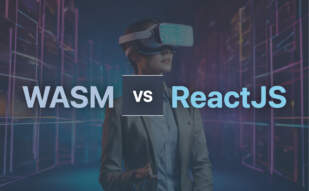
ReactJS

Developed by Facebook in 2011, ReactJS is a powerful, open-source JavaScript library that structures dynamic and interactive web applications. It has grown in popularity since its inception, deploying on major platforms like Facebook’s News Feed, Instagram, and even Netflix.
ReactJS Top Features
- JSX: A synthesis of JavaScript and HTML, JSX renders coding structurally simple yet potent. The Babel compiler transforms this compound into concrete JavaScript.
- Virtual DOM: This quintessential characteristic of ReactJS is an optimized clone of the actual DOM. It culminates in a distinctly quicker update process by modifying only the affected elements, enhancing performance.
- One-Way Data Binding: In ReactJS, data cascades from parent to child components, solidifying a sturdy, predictable data model.
- Extensions: ReactJS promotes full-feature UI applications, mobile app developments, and server-side rendering, broadening its utility.
| Conditional Statements: | JavaScript Syntax Extension (JSX) enables conditional statements, offering developers flexibility to manipulate data display based on influencing conditions. |
| Ecosystem: | React’s ecosystem entails Redux, React Native, React Router, and more, offering a comprehensive toolset for developers. |
| Components: | ReactJS segregates the UI into manageable components, encouraging clean and efficient programming. |
ReactJS Limitations
- Complexity of JSX: Developers unfamiliar with JSX may find the learning curve steep.
- Poor Documentation: As React undergoes rapid development, documentation can often lag behind, making it challenging for developers to stay updated.
- View Part only: ReactJS only covers the view layer in MVC (Model-View-Controller), requiring developers to integrate with other technologies for a complete solution.
ReactJS Pricing
ReactJS is open-source and free to use, encouraging a wider adoption amongst developers and businesses alike.
ReactJS Use Cases
Use case 1: Large-scale Applications
ReactJS has proven its credibility through its integration in large-scale applications like Facebook, Instagram, and Netflix, primarily owing to its efficient data handling.
Use case 2: Mobile Applications
With React Native, ReactJS extends to mobile application development, providing the agility and performance consistent with its web services.
Use case 3: SEO-friendly Web Applications
React’s capability to perform server-side rendering makes it ideal for SEO-friendly web applications which require dynamic and interactive UI.
React
In the race of JavaScript libraries, ReactJS, bred in the tech stables of Facebook, is prancing ahead with its high functionality, interactive applications, and swoon-worthy UI/UX design. Initially rolled out in 2011, it has since engrossed developers with its open-source, component-based personality mainly leading the UI design parade.
React Top Features
- Armed with JSX (JavaScript Syntax Extension), ReactJS blurs the line between JavaScript and HTML, allowing developers to orchestrate HTML structures in JavaScript.
- Waving the magic wand of Virtual DOM, it showcases a high-performance act, making other JavaScript libraries green with envy.
- It introduces one-way data binding and server-side rendering, boosting load speeds, and SEO-friendliness.
- With stateless functional and stateful class components, React adds a playful swing to the development and debugging scene.
| Reusable UI components | Boosts development and debugging processes |
| New React 18 APIs | createRoot, hydrateRoot, renderToPipeableStream, renderToReadableStream |
| New React 18 Hooks | useId, useTransition, useDeferredValue, useSyncExternalStore, useInsertionEffect |
React Limitations
- ReactDOM.render and renderToString, once the limelight grabbers, have now been cornered and replaced with createRoot in React 18.
- For those enticed by React 18, you’ll need to part ways with the nostalgic ReactDOM.render and welcome npm installation of React and React DOM.
React Pricing
Utter the magic words “Open Source”, and React appears – free for all. However, mind you, you do pay with your time and effort!
React Use Cases
Use case 1
Netflix and Airbnb took a liking to React between 2014 and 2015, which markedly emphasizes its aptness for building high-traffic web applications.
Use case 2
With its foothold in Instagram‘s tech stack, React proves its mettle for developing social media applications.
Use case 3
Facebook’s remodel with xhp in 2010, a feature now integral to React, underscores its utility for website revitalization.
p5.js
Entering the virtual stage is p5.js, a sleek and sassy alternative to JavaScript. It’s like JavaScript’s avant-garde cousin who attended art school. Born out of the Processing Foundation, and sprinkling dashes of Java, GLSL and JavaScript, it added color to the black and white world of coding languages from the day it entered the scene. The brain-child of Casey Reas and Ben Fry, it started turning heads in the tech world from its debut in 2001. Now, let’s lay down the main attractions!
p5.js Top Features
- It spices up web browser display of visual content and game rendering in 2D and 3D, where it wears its HTML canvas element like a flamboyant hat.
- It does not discriminate; whether you are a fan of Mozilla Firefox, Opera, Internet Explorer, Safari, or Google Chrome, p5.js has your back!
- Has got ease on its side with a user-friendly IDE sketchbook and support for cross-platform development.
- Promotes the Making Coding Fun Again campaign with a focus on visual design, teaching non-programmers the titbits of computer programming in a visual context.
| Feature | Details |
|---|---|
| Award Winner | Snagged the prestigious Golden Nica award from Ars Electronica in 2005, and the National Design Award from Smithsonian Cooper-Hewitt National Design Museum in 2011. |
| Language Flexibility | No standard data type limitation, plus pure Java with additional simplifications in the graphical user interface. |
p5.js Downsides
- Oh, the dramas of class creation! User class creation is in PApplet sketch, making it a bit of a show.
- Got a bit of a performance issue with heavy-duty 3D graphics.
- May require a bit of getting used to, especially for folks new to programming.
p5.js Pricing
This kind-hearted performer doesn’t believe in putting a price tag on creativity. It’s open-source and free for all. All you need is the passion to create and innovate!
p5.js Use Cases
Use case 1: Web Graphics
For those web developers and designers who are looking to add a dash of artistry to their work, p5.js offers a delightful platform to create masterpieces.
Use case 2: Interactive Art Creation and Simulation
If you are an artist or designer who loves to swim in the pool of interactive art and simulation, jump in! The water in p5.js is just the right temperature!
Use case 3: Teaching Programming
First-time coders and instructors, rejoice! With p5.js, teaching and learning programming becomes a piece of (colorful) cake!
Godot
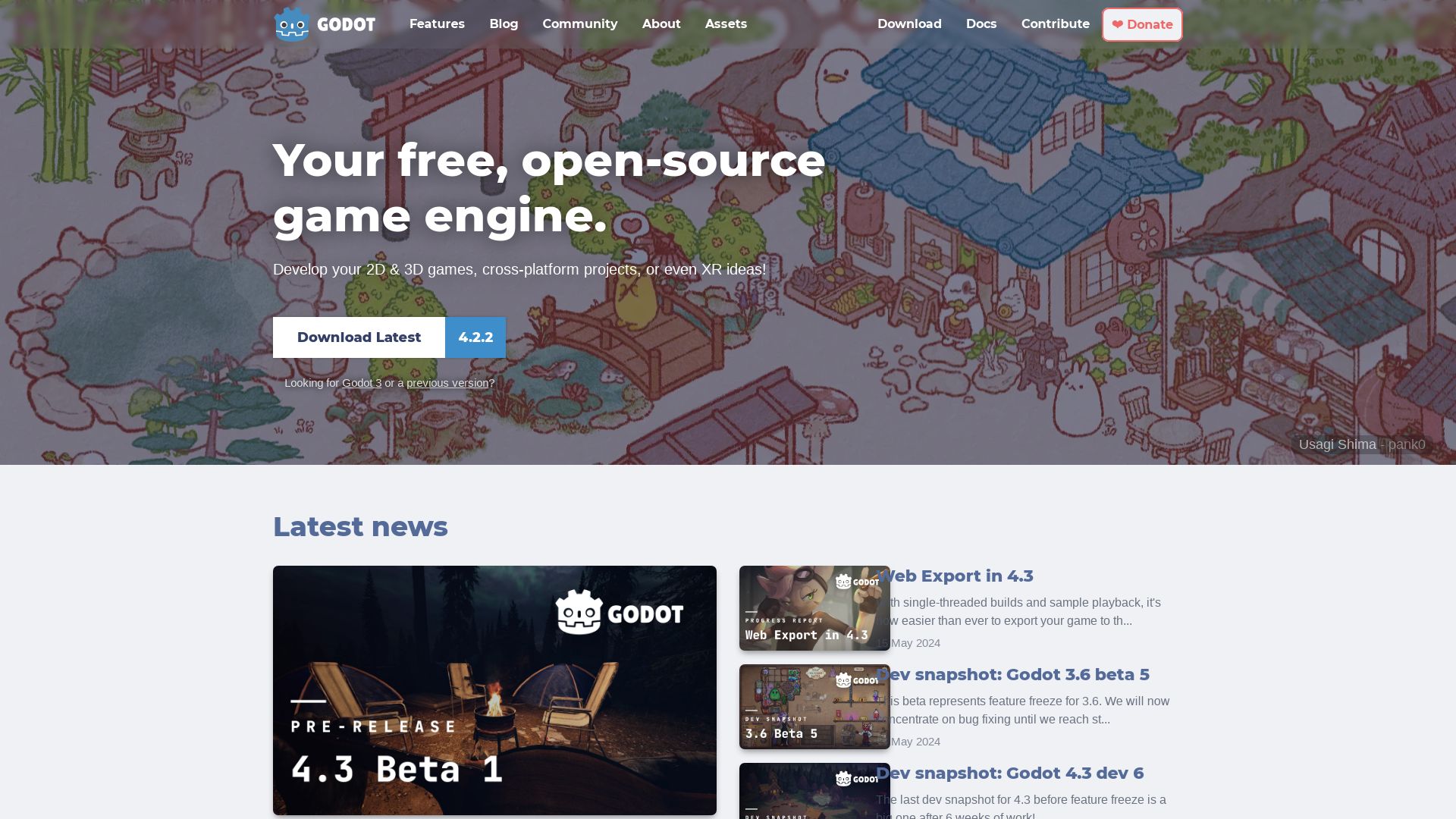
Enter the multiverse of game design with Godot, an open-source and free game engine gaining substantial traction across the globe. With an intuitive scene-driven design and capability to create games simply or with complexity, Godot is a popular choice among developers from diverse corners of the world.
Godot Top Features
- Scene-Driven Design: Build your game from simple blocks using nodes for complex, reusable scenes. Scenes can be compounded into full-featured components.
- Flexible Scripting: Choose from myriad languages including built-in GDScript, C# for .NET platform, and through community support other language bindings: Rust, Nim, Python are available; with official C++ support starting with Godot 4.0.
- 3D and 2D Rendering: Godot’s engine supports high and low-end devices while also offering a specialized 2D workflow.
- Inclusive Compatibility: Godot 3.5 supports Android smartphones and tablets, along with many other mobile and web platforms.
- Advanced Audio: An Audio Bus/Layout system with real-time effects.
| Feature | Benefit |
|---|---|
| Direct import of Blender files | Saves time in resource integration. |
| Free, open-source and modifiable codebase | Maintains financial and creative freedom. |
| Storage solution designed for team collaboration | Enhances productivity and communication in multi-person projects. |
Godot Limitations
- Complex 3D game development can be challenging due to inherent feature limitations.
- .NET support is only available for desktop platforms in Godot 4.
Godot Pricing
Enjoy the liberty of open-source software with Godot, free under the MIT license. No hidden charges, contracts, or licensing fees involved.
Godot Use Cases
Use case 1
For beginners venturing into game development, Godot offers an ideal playground with an easy learning curve and visual editor built into the engine.
Use case 2
Experienced game developers can leverage Godot’s flexibility, customization features, and its robust community support for advanced languages.
Use case 3
Teams designing cross-platform games, will find Godot’s extensive platform compatibility a boon for their process.
Unreal Engine
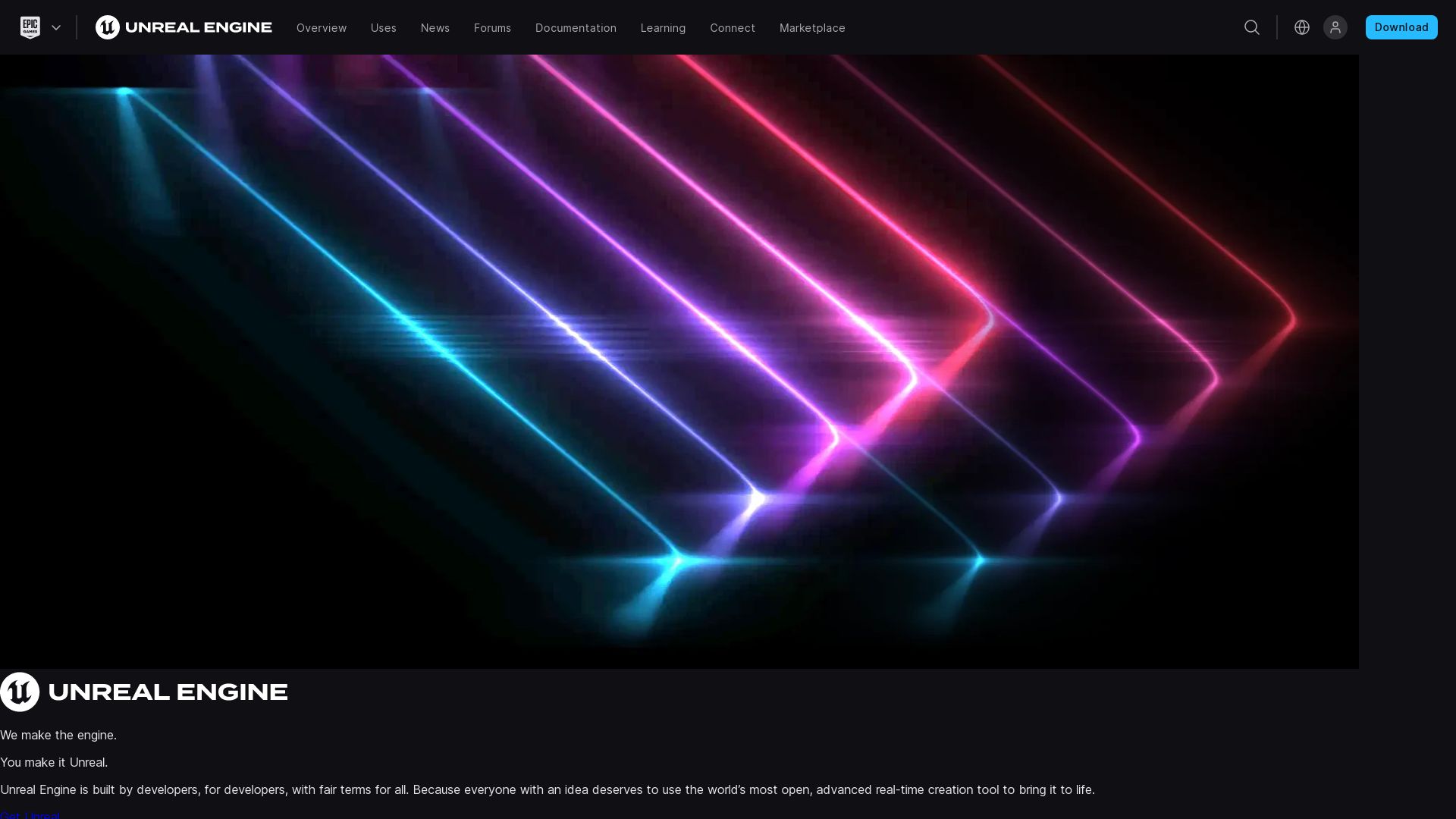
Meet the Unreal Engine (UE), a series of 3D computer graphics game engines developed by Epic Games. Since its showcase in 1998, the first-person shooter PC game ‘Unreal’, it has evolved to support various game genres and platforms, including desktop, mobile, console, and virtual reality platforms.
Unreal Engine Top Features
- Written in C++, UE supports a wide array of platforms. It even includes mobile and console game development.
- UE contains a level editor, UnrealEd, that facilitates real-time constructive solid geometry operations.
- It incorporates features from companies Epic has acquired, such as Quixel.
- Free for use by schools and universities, promoting tech education.
- Provides basic project templates serving as excellent starting points for a first-person or third-person experience.
| Features | Benefits |
|---|---|
| Unreal Development Kit (UDK) | Aids in creating iOS games and apps. |
| Unreal Engine Marketplace | Allows users to sell or purchase developers’ creations with an 88% revenue share. |
| Unreal Engine 5 | Latest version offering state-of-the-art capabilities for game development. |
Unreal Engine Downsides
- Commercial use of UE is subject to a 5% charge on revenues exceeding USD 1 million.
- Written in C++, which could be a challenge for developers without a background in this language.
Unreal Engine Pricing
Epic Games releases Unreal Engine for free while charging 5% of revenue for products earning more than $3,000 per quarter. However, the royalty model is waived for games published on the Epic Games Store.
Unreal Engine Use Cases
Use case 1
The Unreal Engine is immensely beneficial to professionals in the film and television industries, offering them powerful graphics and simulation capabilities for their projects.
Use case 2
The Unreal Development Kit makes the engine a popular choice for iOS game and app developers, providing comprehensive support and capabilities.
Use case 3
Educational institutions can leverage UE for free, making it an ideal tool for teaching game design and development.
Python
Ascend into the realm of Python, a high-level, interpreted, and object-oriented scripting language, harmoniously constructed for readability with its English keywords. Known for its beginner-friendly, open-source, cross-platform ethos, it effectively pierces the technology landscape like a philosopher’s sharp insights.
Python’s Noteworthy Features
- Accessibility: A beginner-friendly language that prioritizes readability over complexity
- Flexibility: Adheres to object-oriented programming style while also supporting imperative, structured, and functional programming techniques
- Community Support: Boasts an expansive, interactive community ensuring constant evolution and improvements
- Variability: Python’s dynamic memory allocation eliminates the need to preemptively specify variable data types
| Python’s Genesis | Python’s Guiding Philosophy |
|---|---|
| Created by Guido van Rossum, Python pays homage to diverse languages, integrating the best of ABC, Modula-3, C, and others | Follows the ‘Zen of Python’ aphorisms – a testament to its commitment to simplicity and readability, a meditative chant for programming’s monastic order |
| Python matured in two stages: the intuitive Python 2 and the forward, backward-incompatible Python 3 | Thanks to its adaptability and readability, Python is widely adopted for diverse purposes from AI to web development |
Python’s Limitations
- Interpreter processes at runtime, which can lead to slower execution when compared to pre-compiled languages
- Python 3, while an improvement, is not backward compatible with Python 2, potentially causing discrepancies
Python Pricing
Nestled in the benevolent embrace of the open-source community, Python is free for all to utilize and contribute towards.
Python Use Cases
Use Case 1: Web Development
With support for backend and frontend web development and a large standard library, Python offers a comprehensive toolkit for web developers.
Use Case 2: Artificial Intelligence
An inspiring partner for the AI enthusiast, Python’s simplicity and flexibility make it an excellent choice for AI applications.
Use Case 3: Education
The readability and simplicity of Python make it a popular choice for introducing programming concepts in educational scenarios.
Java Virtual Machine
The Java Virtual Machine (JVM) is a program designed to launch other programs. It delivers a portable execution environment, providing a consistent framework for Java-based apps to perform at their peak, regardless of the device or OS. The JVM streamlines resource usage, optimizes memory in java programs and supports openness in development.
Java Virtual Machine Top Features
- Portability: The JVM stays true to the “write once, run anywhere” principle, allowing Java programs to run on diverse devices and operating systems.
- Performance Boost: Through optimized memory management and garbage collection, the JVM enhances the performance of Java apps.
- Compatibility: Although primarily defined for Java, the JVM has been extended to support several other languages with access to Java libraries.
- Containerization: The JVM has found critical utility in container-based apps development, especially with technologies such as Docker and Kubernetes.
- Microservices architecture: The JVM’s standard configuration and monitoring abilities make it an ideal choice for microservices architecture.
| Feature | Benefit |
|---|---|
| Bytecode Interpretation | JVM’s universal bytecode interpretation allows isolated duplication of real machine. |
| Virtual Threads | The forthcoming introduction of virtual threads could introduce improved coding idioms and performance. |
| Resource Allocation | The execution engine of JVM is responsible for allocating and maintaining resources, improving system efficiency. |
Java Virtual Machine Limitations
- Complexity: JVM’s complexity can pose a challenge for developers who are not familiar with Java and related technologies.
- Performance: Relative to programs running on non-virtual machines, JVM can occasionally have slower execution times.
- Error Handling: JVM can report launcher errors when required components are missing on launch.
Java Virtual Machine Pricing
The JVM is an inherent part of both the Java Runtime Environment (JRE) and Java Development Kit (JDK), available as open-source software and hence, free to use.
Java Virtual Machine Use Cases
Use Case 1: Containerized App Development
In the modern world of microservices architecture and containerized app development, JVM is crucial to enable seamless execution and resource management.
Use Case 2: Cross-Platform Software Development
The JVM is essential for developers targeting diverse platforms, thanks to its “write once, run anywhere” capacity.
Use Case 3: Memory-Intensive Applications
The JVM’s efficient memory allocation and garbage collection make it highly valuable for developing memory-intensive apps.
Containers

Operating as isolated environments, known as sandboxes, containers ensure enhanced software portability, consistency, and swift deployment. Its core functionality is unaffected by variations in hosting environments, operating systems, or hardware. The open platform Docker stands as a notable example for container-based solutions, separating applications from infrastructure and delivering software swiftly.
Containers Top Features
- Isolation and Security: Containers provide secure, isolated environments for applications and their dependencies.
- Portability: Docker’s container-based platform ensures high workload portability.
- Lightweight and Fast: Docker is lighter and faster compared to hypervisor-based virtual machines.
- Client-Server Architecture: Docker utilizes a client-server architecture where the Docker client communicates with Docker’s daemon.
- Image Management: Docker’s run and pull commands allow for easy image management.
- Container Management Tools: Container management is simplified with various tools such as Ceph, REX-Ray, Flannel, and Jenkins.
- Kubernetes Integration:Major cloud vendors provide Kubernetes services for easy enterprise container project management.
- Container Security: Security is emphasized after Docker separated from Docker Enterprise in 2019.
| Tool | Description |
|---|---|
| Docker Objects | Includes the creation and use of images, containers, networks, volumes, plugins. |
| Container Runtime Engines | Docker, containerd, CRI-O, and rkt are key runtime engines for containers. |
| Kubernetes-based Platforms | RedHat and Rancher’s Kubernetes-based management platforms have broadened container tool functionality. |
Containers Limitations
- Complex Licensing: Linux Foundation’s whitepaper reveals complexities of OpenSource Licensing for Docker Containers.
- Manual Source Code Gathering: Docker’s ecosystem does not provide automatic gatherings and publication of source code which indicates an unresolved problem.
Containers Use Cases
Use case 1: Large Scale Software Infrastructure
Introduced around 2013, Docker has been an integral part of large scale software infrastructure, enabling high portability of workloads and swift software delivery.
Use case 2: Enterprise Container Projects
With major cloud vendors offering Kubernetes services and tools like Jenkins, managing enterprise container projects has been simplified.
Use case 3: Hybrid Cloud Transition
VMWare’s acquisitions of Heptio and Pivotal Software and the trend of Kubernetes-based hybrid-cloud solutions are facilitating hybrid cloud transitions across the industry.
Docker

Docker, a noted technology company, seized the spotlight with their development of Docker Engine. A stalwart in container technology, Docker has popularized this technique since its first release in 2013. Standardized units of software, which include codec, runtime, system tools, libraries, and settings, can run reliably across diverse computing environments with Docker at helm.
Docker’s Best Features
- Application Portability: Docker containers allow for portable workloads, suitable for various environments, like physical/virtual machines, data centers, and cloud providers.
- Management Flexibility: Docker facilitates running multiple applications on the same operating system. When paired with virtual machines, it amplifies the flexibility of application management.
- Resource Efficiency: Docker containers have a smaller resource footprint and require less management overhead compared to virtual machines, enhancing resource management and resource allocation.
- Speedy Setup and Tear-down: Docker containers are renown for their quick setup and tear-down speeds, vastly improving software delivery speed.
- Security: With the industry’s focus on security, Docker’s container technology enhances security features tied to application deployment.
| Container Tooling | User-Friendly GUI |
|---|---|
| Docker provides tooling and a platform to manage the lifecycle of containers. | Docker popularized container technology with their user-friendly GUI, simplifying the packaging, management and running of containerized software. |
| Open-Source | Industry Standardization |
| Being open-source, Docker allows for continued evolution and contribution to container technology. | Docker’s technology has significantly influenced industry standardization, with its technology leveraged by major data center vendors and cloud providers. |
Docker Limitations
- New runtime engines like containerd and CRI-O are gradually replacing Docker’s runtime engine.
- While Docker’s technology separates application dependencies from infrastructure, this could pose challenges in certain application environment scenarios.
- The rapid evolution of container technology, resulting in an influx of new tools and technologies, can be overwhelming and requires ongoing learning.
Docker Use Cases
Use case 1: Continuous Integration and Delivery Workflows
Docker’s standardization of software units makes it perfectly suited for continuous integration (CI) and continuous delivery (CD) workflows.
Use case 2: Cloud Providers and Data Centers
Major data center vendors and cloud providers benefit from Docker’s container technology for consistent application deployment and system optimization.
Use case 3: Lightweight Virtual Machining
For lightweight virtual machine scenarios, Docker’s containers, paired with technologies like Kata containers, gVisor, and Nabla, provide secure runtimes.
Ethereum Virtual Machine
Ethereum Virtual Machine (EVM) is the heart of the Ethereum protocol, functioning as a state machine that powers smart contracts and maintains the Ethereum blockchain state with unbroken, tamper-proof operation.
Ethereum Virtual Machine Top Features
- Runtime Environment: EVM provides the environment where Ethereum smart contracts exist and operate.
- Secure Transactions: EVM performs both message calls and contract creations, ensuring every transaction happens accurately as per the predefined smart contract code.
- Turing Completeness: Possessing the capability to run programs written in multiple languages, EVM confirms broad adaptability and versatility.
- Standard Setters: Establishing the rules for generating new valid states and updating existing ones, EVM partakes in block creation and transaction execution.
- Implementation Variety: Multiple implementations available including Py-EVM, evmone, ethereumjs-vm, and eEVM.
| Feature | Description |
|---|---|
| Distributed State Machine | Enables block by block execution of smart contract functionalities using established rules. |
| Depth of Stack Machine | Allows execution of instructions up to a depth of 1024 items, with each item being a 256-bit word compatible with 256-bit Keccak-256 hashes/secp256k1 signatures. |
| Memory Management | Provides transient memory during execution that doesn’t persist between transactions, ensuring optimal performance. |
Ethereum Virtual Machine Limitations
- High Costs: Both the storage of data and the execution of complex smart contracts come with considerable “gas” costs.
- Technical Expertise: Writing smart contracts and managing transactions on EVM requires a good grounding in bytes, memory, stacks, and other cryptographic concepts.
- Future Uncertainty: There’s a possibility of EVM being phased out in favor of Ethereum WebAssembly (eWASM) in the future.
Ethereum Virtual Machine Use Cases
Use case 1
EVM is ideal for developers aiming to build decentralized applications (DApps). It provides the platform, the rules, and the security needed to write sophisticated smart contracts.
Use case 2
For businesses aiming to harness the potential of blockchain, EVM offers a robust and proven environment to create and manage blockchain states.
Use case 3
EVM can act as a trusted intermediary for financial transactions, as it ensures that all exchanges are correctly executed according to an unerring smart contract code.
LibGDX
In the vast, ever-evolving realm of Java game development, there exists a titan known by the name of LibGDX. A unified & steadfast framework with over a decade of existence, LibGDX is the sentry that stands firm across multiple platforms such as Windows, Linux, macOS, Android, iOS and Web.
LibGDX Top Features
- Unified API: Target multiple platforms from a single code base.
- OpenGL ES Rendering: Adept in handling both 2.0 and 3.0, LibGDX exhibits considerable prowess in graphics rendering.
- Audio Engineering Capabilities: Exhibits support for streaming WAV, MP3, OGG, along with direct PCM sample playback and recording.
- Comprehensive Input Handling: From mouse, keyboard, and touchscreen to more complex controllers, accelerometer, gyroscope, and compass, LibGDX covers it all.
| Integration Skills | 3D API Features |
| Integration with Google Play Games, Apple Game Center, Firebase, Steamworks API, gameanalytics.com, Facebook’s Graph API, to AdMob speaks volumes about LibGDX’s versatility. | Included are decal batching, loaders for Wavefront OBJ and MD5, lighting systems, GLTF 2.0 support, VR support. |
LibGDX Limitations
- Code-centric: Helming from a Java background, LibGDX leans towards code-centric development which might come off as challenging for non-coders.
- Fine-grained control: Though beneficial for professionals, newcomers might find it difficult to grasp.
LibGDX Pricing
Expanding the realm of possibilities without shrinking your wallet, LibGDX is completely free to use.
LibGDX Use Cases
Use case 1
In an era of platform variety, developers aiming for cross-platform game development will find LibGDX an indispensable ally, thanks to its unified API.
Use case 2
For 3D game development enthusiasts, LibGDX’s extensive 3D API, from simple loaders to a complex VR support, will prove to be a treasure trove of capabilities.
Android Studio
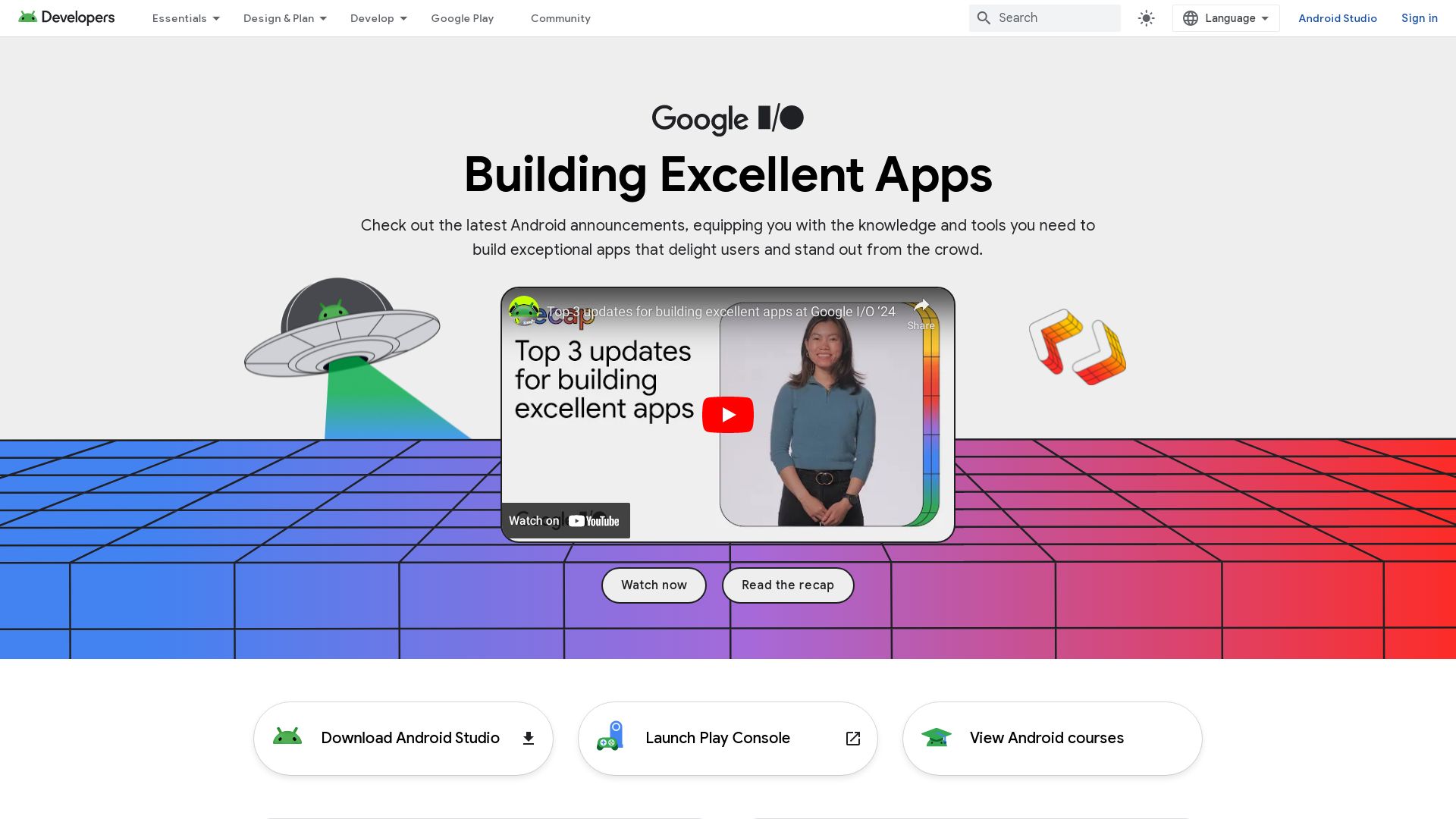
Anointing the digital landscape with an unmatched versatility, Android Studio reigns as the official IDE for Android app development. Infused with the fortitude of IntelliJ IDEA code editor and a plenitude of developer tools, it stands as a lighthouse guiding developers through the labyrinth of app creation.
Android Studio Top Features
- Flexible Gradle-based build system, paired with a fast, feature-rich emulator
- Unyielding support for development across all Android devices
- Enthralling live-edit capabilities for updating composites across emulators and physical devices in mere seconds
- Provides code templates and seamless GitHub integration, thereby catalyzing feature building and sample code import
- Armed with extensive testing tools and frameworks, efficiently resolves performance, usability, version compatibility issues
- Ample support for C++ and NDK, along with built-in support for Google Cloud Platform
| Additional Features | Description |
|---|---|
| High-Resolution GUI for App Development | Fosters the development of apps equipped for various resolutions and locales |
| Android Virtual Device (Emulator) | Facilitates the efficient running and debugging of apps |
| Inline Debugging | Crucial for efficient code walkthroughs and performance analysis |
Android Studio Limitations
- The abundance of features may sometimes prove overwhelming for novice developers.
- Requires a computer with a minimum of 8 GB RAM and 8 GB disk space, alongside a screen resolution of 1280 x 800.
- While rich in functionality, the IDE is not as lightweight as some of its competitors.
Android Studio Pricing
Behold the quintessence of freedom in technology – Android Studio is free to all, bridging the gap between idea and implementation.
Android Studio Use Cases
Use case 1: Android App Development
From startups stepping onto the stage of app creation to established firms seeking to expedite their Android app development process, Android Studio is their sure companion.
Use case 2: Software Testing
Equipped with robust testing tools and frameworks, Android Studio minimizes errors and elevates the quality of the application exponentially.
Use case 3: Multilingual App Development
For developers questing to build multilingual Android applications, Android Studio simplifies the journey with its high-resolution GUI that fosters applications suited to various locales.
Phaser
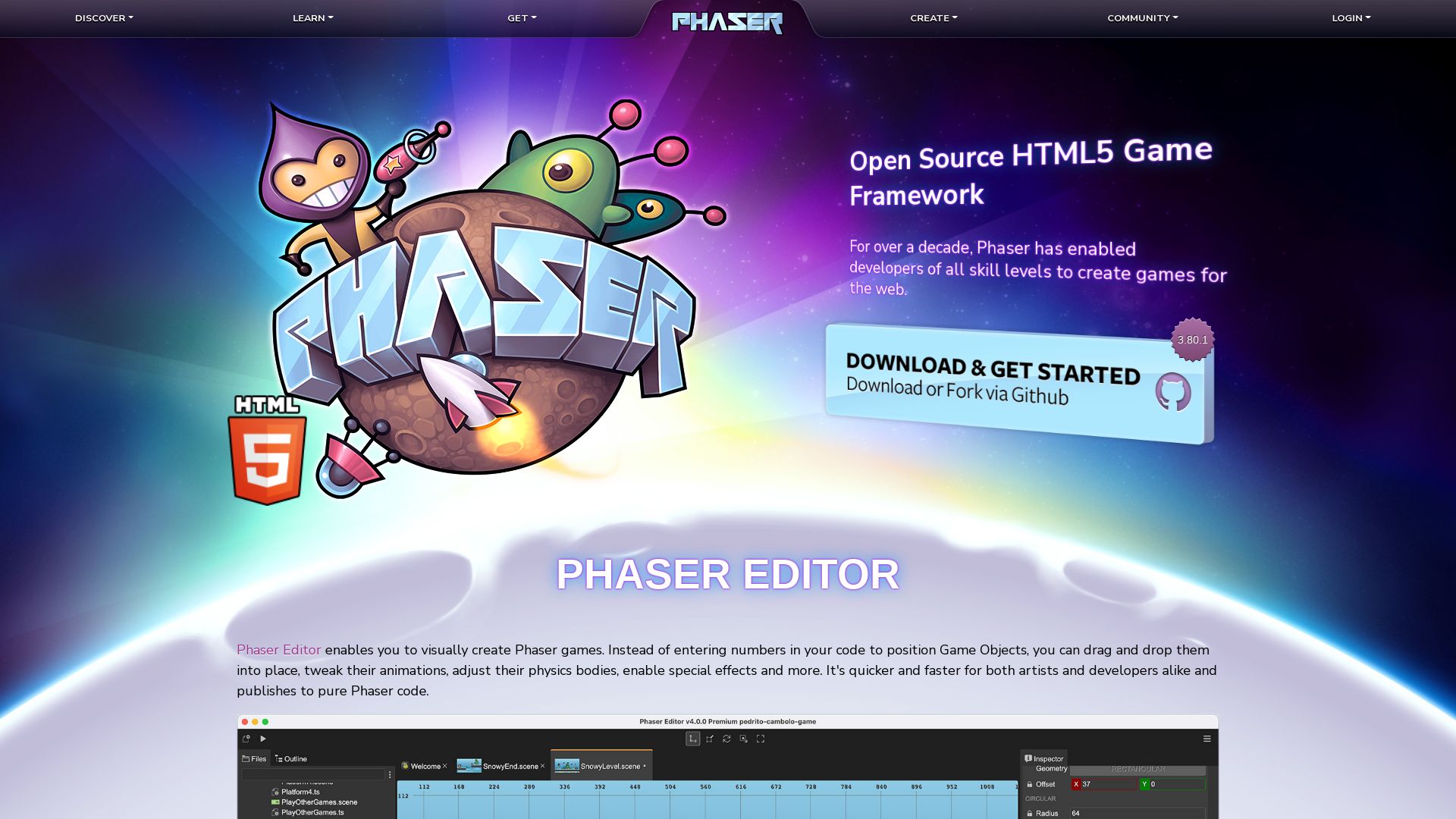
A forerunner in 2D game framework, Phaser creates HTML5 games for desktop and mobile platforms. Conceived by Richard Davey, its inception dates back to April 2013. Catering to a cross-platform base, it aligns with both JavaScript and TypeScript.
Top Phaser Features
- Boasts a dual-rendering system: Canvas and WebGL to bolster quick rendition. It adapts bases on browser compatibility.
- Possibility of deploying games on iOS, Android, and native desktop apps via interfaces such as Apache Cordova and PhoneGap.
- The provision of multiple physics systems such as Arcade Physics, Ninja Physics, and P2.JS.
- 1800+ examples and ardent community support make game development facile.
- Can be used via es6+webpack, CDN, or TypeScript, indicating high adaptability, and can be suited to Android games or Facebook Instant Games.
| PHASER VERSIONS | DESCRIPTION |
|---|---|
| Phaser 1 | Includes Pixi.js library |
| Phaser 2.6.2 | Last official Phaser 2 version |
| Phaser CE | Current recommended stable platform |
| Phaser 3 | Features custom WebGL renderer, modular structure with active GitHub development |
| Phaser 4 | In-development TypeScript rewrite of Phaser 3 |
Phaser Limitations
- No noted limitations in the provided information
Phaser Pricing
Phaser is an open-source platform, hence no pricing applies.
Phaser Use Cases
Use Case 1:
Game developers aiming to craft browser-supported games find Phaser an enabling tool due to compatibility with any browser that supports the canvas element.
Use Case 2:
Novices get a constructive launching pad in the arena of game development due to Phaser’s robust and supported learning resources, including a Phaser Mini-Degree from Zenva Academy.
Use Case 3:
Users seek Phaser for its versatility in game creation. An instance of the process includes the use of new Phaser.Game() method for new game creation, and functions like preload() for incorporating all declared assets towards game creation.
Grant Sullivan
Content writer @ Aircada and self proclaimed board game strategist by day, AI developer by night.





